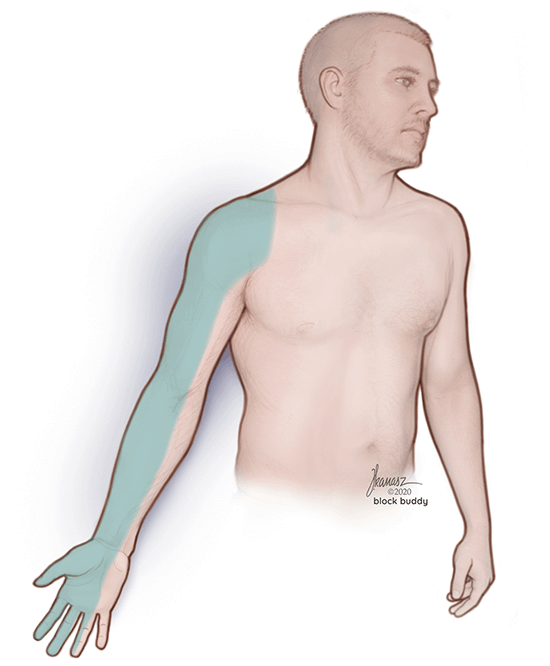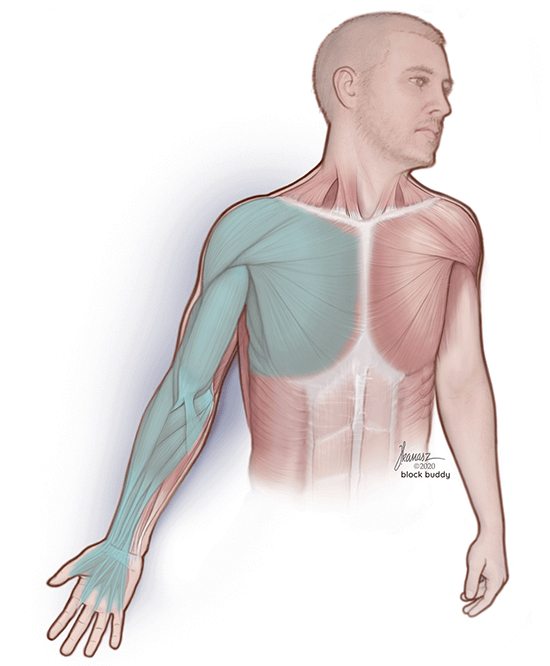Interscalene Block



The interscalene block is a regional anesthesia technique that effectively blocks sensations to the shoulder and upper arm. Generally, patients in need of shoulder or upper arm surgery are typical candidates for this nerve block. Some procedures that commonly require an interscalene block include:
- Shoulder Arthroscopy
- Distal Clavicle Resection
- Rotator Cuff Repair
- Labral Repair
- Acromioplasty
- Proximal Humerus Fractures
- Total Shoulder Replacement
Overview of the Interscalene Block
The interscalene block is a common regional nerve block that is often administered before surgery, but can also be performed as a rescue block in recovery. Many anesthesia providers prefer using interscalene blocks because they decrease intraoperative anesthetic requirements, reduce postoperative nausea and vomiting, and shorten the length of stay in recovery. They also reduce post-surgical pain, which minimizes or avoids the need for opioid medications.
Risks and Side Effects of the Interscalene Block
As with any procedure that involves anesthesia, an interscalene block carries its own set of risks. Some common risks and complications include:
- Phrenic nerve blockade
- Recurrent laryngeal nerve blockade
- Pneumothorax
- Local anesthetic systemic toxicity (LAST)
- Infection
- Allergic reaction
- Horner syndrome
- Hematoma
- Nerve injury
How to Perform an Ultrasound-Guided Interscalene Block
The interscalene block targets the brachial plexus, a network of nerves that pass between the anterior and middle scalene muscles. These nerves provide sensory and motor innervation to the shoulder, arm and hand. Ultrasound can be used to identify the nerve roots of the brachial plexus and guide placement of the block needle.
Then, deposit local anesthetic around nerve roots C5-C7 within the interscalene groove to provide anesthesia to the distal clavicle, shoulder, and lateral aspect of the upper extremity. This approach to the brachial plexus does not reliably block the nerve roots C8-T1. If prolonged analgesia is required, a small indwelling catheter may be left in place for up to 72 hours after surgery. Depending on the type of local anesthetic used, the onset of the interscalene block can take anywhere from 5 to 30 minutes.
Get Full Step-by-Step Instructions in Block Buddy Pro
As a student or medical professional, consider Block Buddy Pro your new best friend! It’s the ultimate resource to help anesthesia providers administer ultrasound-guided nerve blocks. Specifically, the Interscalene Block Lesson in the Block Buddy Pro app includes:
- Simple instructions that are easy to follow and understand.
- 20 images consisting of detailed illustrations, ultrasound images, and photos from inside the operating room.
- A narrated video with step-by-step instructions.
- An equipment list, CPT codes, and more!
You’ll have access to tons of other detailed lessons with their own step-by-step instructions, images, and videos. You can even add important notes for yourself right in the app, and have access anytime, anywhere with offline mode. Block Buddy Pro can be used on all devices (mobile, tablet and desktop) and is available in the App Store and Google Play Store. To get started, simply create your account now!
